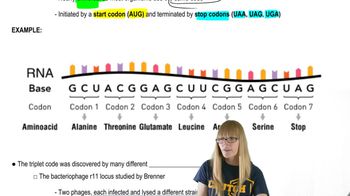How were the experimentally derived triplet codon assignments verified in studies using bacteriophage MS2?
Table of contents
- 1. Introduction to Genetics51m
- 2. Mendel's Laws of Inheritance3h 37m
- 3. Extensions to Mendelian Inheritance2h 41m
- 4. Genetic Mapping and Linkage2h 28m
- 5. Genetics of Bacteria and Viruses1h 21m
- 6. Chromosomal Variation1h 48m
- 7. DNA and Chromosome Structure56m
- 8. DNA Replication1h 10m
- 9. Mitosis and Meiosis1h 34m
- 10. Transcription1h 0m
- 11. Translation58m
- 12. Gene Regulation in Prokaryotes1h 19m
- 13. Gene Regulation in Eukaryotes44m
- 14. Genetic Control of Development44m
- 15. Genomes and Genomics1h 50m
- 16. Transposable Elements47m
- 17. Mutation, Repair, and Recombination1h 6m
- 18. Molecular Genetic Tools19m
- 19. Cancer Genetics29m
- 20. Quantitative Genetics1h 26m
- 21. Population Genetics50m
- 22. Evolutionary Genetics29m
11. Translation
The Genetic Code
Problem 2d
Textbook Question
In the experiments that deciphered the genetic code, many different synthetic mRNA sequences were tested.
Predict the results of experiments examining GCUA repeats.
 Verified step by step guidance
Verified step by step guidance1
Understand the problem: The question involves deciphering the genetic code using synthetic mRNA sequences. The sequence provided is a repeating GCUA. Each codon (group of three nucleotides) in the mRNA sequence corresponds to a specific amino acid based on the genetic code.
Break the repeating sequence into codons: The sequence GCUA repeats, so write it as GCUA GCUA GCUA... and identify the codons. Since codons are groups of three nucleotides, the sequence will produce overlapping codons: GCU, CUA, UAG, and so on.
Determine the amino acids for each codon: Use the genetic code table to find the amino acids corresponding to each codon. For example, GCU codes for Alanine (Ala), CUA codes for Leucine (Leu), and UAG is a stop codon.
Predict the results: The presence of a stop codon (UAG) in the sequence will terminate translation. Therefore, the polypeptide produced will depend on where translation starts and will stop when the ribosome encounters the UAG codon.
Summarize the findings: The repeating GCUA sequence will produce short polypeptides that vary depending on the reading frame. Translation will terminate at the UAG stop codon, and the specific amino acids in the polypeptide will depend on the codons read before the stop codon.
 Verified video answer for a similar problem:
Verified video answer for a similar problem:This video solution was recommended by our tutors as helpful for the problem above
Video duration:
3mPlay a video:
Was this helpful?
Key Concepts
Here are the essential concepts you must grasp in order to answer the question correctly.
Genetic Code
The genetic code is a set of rules that defines how the sequence of nucleotides in mRNA is translated into amino acids, the building blocks of proteins. It consists of codons, which are triplets of nucleotides, each corresponding to a specific amino acid or a stop signal during protein synthesis. Understanding the genetic code is essential for predicting the outcomes of experiments involving mRNA sequences.
Recommended video:
Guided course

The Genetic Code
mRNA and Translation
Messenger RNA (mRNA) is a type of RNA that carries genetic information from DNA to the ribosome, where proteins are synthesized. During translation, ribosomes read the mRNA sequence in codons, facilitating the assembly of amino acids into a polypeptide chain. The specific sequence of mRNA, such as GCUA repeats, will influence the resulting protein's structure and function.
Recommended video:
Guided course

Translation initiation
Repetitive Sequences
Repetitive sequences in mRNA, such as GCUA repeats, can affect the stability and translation efficiency of the mRNA. These sequences may lead to the formation of secondary structures that can hinder or enhance ribosome binding. Understanding how these repeats influence translation is crucial for predicting the results of experiments involving synthetic mRNA.
Recommended video:
Guided course

Sequencing Difficulties
Related Videos
Related Practice
Textbook Question
401
views


